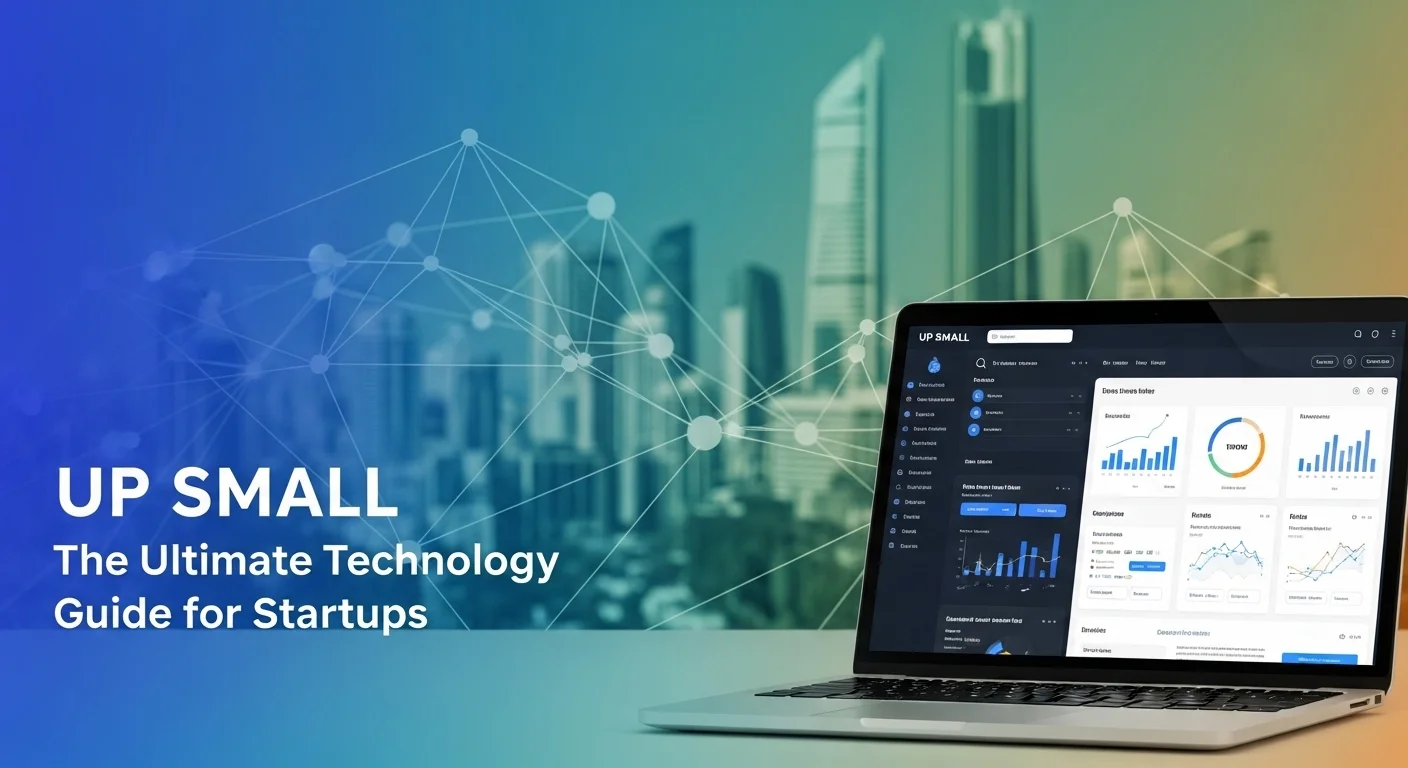Punch Above Your Weight: A Founder's Guide to 'Up Small' Technology

Executive Summary
Starting a business can feel like you're a tiny boat in an ocean of giants. I've been there. You have a brilliant idea, the drive, but your resources are limited. How do you possibly compete? The answer lies in a mindset I've seen transform small ventures into powerhouses: 'Up Small.' It's not just about using tech; it's about being smarter with it. It means leveraging the incredible power of artificial intelligence, the cloud, and rock-solid cybersecurity to operate like a major corporation, but with the speed and agility of a startup. This guide is my roadmap for you. We'll walk through how to turn a home office idea into a scalable business, using technology as your ultimate co-founder. By thinking 'Up Small,' you're not just building a company; you're building a resilient, innovative, and future-proof enterprise from day one.
Table of Contents
On This Page
What is 'Up Small' and Why It's Your Secret Weapon in Technology
In all my years working with startups, I've seen a common thread in the ones that succeed: they think 'Up Small.' It’s a philosophy, really. It means using today's incredible technology to act big while staying lean. It's about a brand-new business leveraging enterprise-grade tools to scale quickly and go toe-to-toe with established players. Forget the old rules where you needed a huge budget to compete. 'Up Small' is about weaving technology into the DNA of your business from the very start. Its importance can't be overstated because technology has leveled the playing field. Tools like cloud computing, AI, and advanced cybersecurity used to be locked away in corporate fortresses. Now, they're available to everyone, and that's what fuels the 'Up Small' revolution. It lets a small business, even one run from a spare bedroom, operate with the sophistication and security of a much larger company.
The core advantage of 'Up Small' is agility. As a new venture, you're not bogged down by decades of old processes or outdated systems. You can adopt new tech in an afternoon, not a fiscal quarter. This allows you to pivot on a dime, respond instantly to what your customers want, and offer a personal touch that big companies can only dream of. For anyone starting a business from home, this is a profound shift. A laptop and a good internet connection are your gateway to a global market, powerful software, and tools that can automate your marketing, analyze your sales, and protect your data. This opens up a world of innovative business ideas, from a niche online shop using AI to predict what customers will love, to a global consulting firm run entirely on cloud collaboration tools.
The Technological Pillars of the 'Up Small' Strategy
To really bring the 'Up Small' idea to life, you need to understand its three core pillars. They aren't separate things to check off a list; they work together to create a powerful engine for your business.
1. Cloud Computing: Your Foundation for Growth
I always tell founders that the cloud is the bedrock of any modern business. It completely removes the need to buy and maintain expensive physical servers, which used to be a massive hurdle for startups. The cloud works on a pay-as-you-go model, giving you incredible flexibility. You can start small and instantly scale up your power, storage, and software as you land more customers. It’s like renting a toolkit instead of buying the whole workshop. Key services include:
- Infrastructure as a Service (IaaS): Think of this as the raw materials. Companies like Amazon Web Services (AWS) or Google Cloud give you virtual servers and storage. You build what you need without owning any hardware.
- Platform as a Service (PaaS): This gives you a workshop to build, test, and run your own applications without worrying about the underlying plumbing. It's perfect for developing a unique piece of software for your business.
- Software as a Service (SaaS): This is the most familiar one. It's ready-to-use software you subscribe to, like QuickBooks for accounting, Salesforce for managing customer relationships, or Google Workspace for collaboration. For a home-based business, SaaS tools are absolute game-changers, giving you immense power for a simple monthly fee.
The beauty of the cloud is that it lets you experiment without breaking the bank. You can test a new app feature for a few hours and only pay for that time. This freedom to innovate is what helps you find that perfect product-market fit.
2. Artificial Intelligence (AI): Your Engine for Efficiency
If the cloud is your foundation, AI is the engine. It's no longer just a buzzword; it's a practical tool that can supercharge your startup. AI automates the boring stuff, uncovers hidden gems in your data, and helps you create amazing customer experiences. For a small team, AI acts as a force multiplier, giving you the output of a team ten times your size.
Here’s how you can put AI to work:
- Automation: Set up AI to handle repetitive tasks like customer service chats, social media posting, or data entry. This frees you and your team to focus on strategy and growth.
- Data Analysis: AI tools can sift through your sales and customer data to give you clear, actionable insights. You'll understand what's working and what's not, allowing you to make smarter decisions.
- Personalization: AI can help you treat every customer like your only customer. It can recommend products they'll love or tailor marketing messages just for them, building incredible loyalty.
- Content Creation: Need a blog post, social media update, or marketing email? Generative AI can give you a fantastic first draft in seconds, helping you maintain a strong online presence without spending all day writing.
3. Cybersecurity: Your Shield of Trust
In our digital world, your data is your most precious asset. Protecting it is non-negotiable. A single data breach can destroy a small business's reputation and finances overnight. That's why cybersecurity is a core pillar of the 'Up Small' strategy. And for those of us working from home, where business and personal networks can blur, it’s even more critical. The great news is that world-class security is within your reach.
Here are the non-negotiable basics:
- Strong Passwords & Multi-Factor Authentication (MFA): This is your front door lock. Insist on complex passwords and enable that second verification step (like a code on your phone) on every important account. It's one of the single most effective security measures.
- Regular Updates: Keep all your software and apps updated. Those updates often contain critical patches for security holes that hackers love to exploit.
- Data Encryption: Encryption scrambles your sensitive data, making it unreadable to anyone who shouldn't have it, whether it's stored on your drive or sent over the internet.
- Team Training: Your team is your first line of defense. Regularly train everyone on how to spot phishing scams and other tricks hackers use.
- Firewalls and VPNs: Use a firewall to guard your network and a Virtual Private Network (VPN) to secure your internet connection, especially when working from public Wi-Fi.
By weaving these three pillars—Cloud, AI, and Cybersecurity—into your business from the start, you're not just building a company. You're building a modern, resilient, high-growth machine ready to take on the world.

A Practical Guide to Implementing 'Up Small' in Your Business
Alright, let's move from theory to action. Starting your 'Up Small' journey requires a practical, step-by-step plan. This is the roadmap I share with founders to help them integrate technology in a smart way, turning a fresh idea into a competitive business. We'll cover the right tools, the right mindset, and the resources you need, whether you're building a global startup or launching a new venture from your kitchen table.
Phase 1: Laying the Foundation - Your First Tech Stack
This first phase is all about building a solid base. The choices you make now will affect your business's speed and security down the line. Remember, the goal isn't to have the *most* tech, but the *right* tech.
Tools and Technical Steps:
- Secure Your Digital Identity: First things first. Get a professional domain name (yourbusiness.com) and set up branded email addresses (e.g., you@yourbusiness.com). It's a small step that makes a huge difference in credibility.
- Choose Your Cloud Home: You absolutely need a cloud provider. I usually tell startups to look at the free tiers offered by AWS, Google Cloud, or Microsoft Azure. See which one feels right and offers services that fit your business idea. Start simple: host your website and use cloud storage like Google Drive or Dropbox.
- Get Your Core Software (SaaS): Subscribe to affordable, cloud-based software to run your operations. You'll need:
- Accounting: Something like QuickBooks Online or Xero to keep your finances clean from day one. Trust me, you'll thank yourself later.
- Customer Relationship Management (CRM): A CRM is essential for tracking every customer interaction. HubSpot offers a fantastic free CRM that's perfect for startups. It helps you manage leads and see your sales pipeline clearly.
- Project Management: Tools like Trello or Asana are crucial for organizing tasks and collaborating, especially if your team is remote.
- Communication: Get on Slack or Microsoft Teams for internal chat and use Zoom or Google Meet for video calls.
- Set Up Basic Cybersecurity: Do this on day one. Install good antivirus software, turn on firewalls, and use a password manager like 1Password to create strong, unique passwords for everything. Most importantly, enable Multi-Factor Authentication (MFA) on your critical accounts (email, cloud, banking).
The Business Mindset:
In this phase, think 'Lean.' Use the Build-Measure-Learn cycle. Use your tech to quickly create a Minimum Viable Product (MVP), use simple tools like Google Analytics to measure how customers respond, and use that data to improve. This stops you from wasting time and money building something nobody wants.
Phase 2: Optimizing for Growth - Streamline and Automate
Once you have some traction and a steady flow of customers, it's time to get more efficient. The goal here is to refine your processes, automate repetitive work, and use data to fuel your growth.
Tools and Technical Steps:
- Automate Your Marketing: It's time to move beyond manual emails. Use your CRM or a tool like Mailchimp to create automated email campaigns that nurture leads. This helps you maintain a personal touch even as you grow.
- Dig Deeper into Your Data: Start connecting the dots. Use tools that pull data from your website, CRM, and sales platform into one place. A simple dashboard in Google Data Studio can give you a bird's-eye view of your business health and uncover powerful insights.
- Start Weaving in AI: Introduce AI where it can have the biggest impact. Add an AI-powered chatbot to your website to answer common questions 24/7. Use AI writing assistants to help create blog posts or social media content faster.
- Strengthen Your Security: As you grow, you become a bigger target. It's time for a formal data backup plan. I recommend the 3-2-1 rule: three copies of your data, on two different types of media, with one stored off-site (the cloud counts!). For those working from home, make sure your home Wi-Fi is locked down with a strong password and WPA3 encryption.
The Business Mindset:
Embrace an agile approach. Break big goals into small, manageable 'sprints.' This keeps you moving and adapting. Start focusing on Customer Lifetime Value (CLV). Use your CRM data to find and reward your most loyal customers—it's cheaper than always hunting for new ones. This is also the perfect time to test new ideas or services, using your tech to launch and validate them quickly.
Phase 3: Scaling Up - Expanding Your Capabilities
Scaling is about preparing for major growth. Your technology must be ready to handle a surge in demand without crashing or compromising security.
Tools and Technical Steps:
- Build a Scalable Cloud Architecture: You might need to move beyond a simple setup. This could mean using load balancers to distribute traffic or exploring 'serverless' computing that automatically adjusts to demand. If this sounds complex, consider a short consultation with a cloud architect.
- Unlock Predictive Power with Machine Learning: With more data, you can start predicting the future. Use AI/ML models to forecast sales, identify customers who might be about to leave, or optimize your inventory. Many of these advanced tools are now offered as services by cloud providers, making them surprisingly accessible.
- Optimize Your Home Office: For the home-based founder, scaling yourself is just as important. Use smart home tech to boost productivity. A smart speaker for hands-free notes, smart lighting that reduces eye strain, and smart plugs to manage your office gear can make a real difference.
- Get Serious About Cybersecurity & Compliance: As you scale, you may need to comply with data regulations like GDPR. Invest in a complete security solution with intrusion detection and have a formal plan for what to do if a breach occurs. You might even consider hiring a part-time 'virtual' security chief to guide your strategy.

Pro Tips and Strategies for Mastering Your 'Up Small' Journey
Becoming an 'Up Small' powerhouse is a continuous process of learning and refining. It’s about cultivating a deep partnership with technology. I've gathered some of the most impactful tips and strategies from my experience in the trenches with startups. These are the practices that separate the companies that merely use tech from those that are transformed by it, from the first spark of an idea to the challenges of scaling a successful business.
Best Practices for a Resilient Tech Foundation
Getting these right from the start will save you countless headaches and build a strong operational core for your business.
- Choose Tech for Your People, Not for a Checklist: When you pick any new tool, from a CRM to a project manager, ask yourself: 'Will my team actually enjoy using this?' If a tool is clunky or confusing, it will gather digital dust. I always advise founders to involve their team in the decision and to prioritize tools that offer great customer support.
- Keep a Simple Technology Roadmap: Don't make tech decisions on the fly. Create a simple roadmap—even a spreadsheet will do—that aligns with your business goals. It should list what you're using now, what you plan to add next, and when you plan to upgrade. This brings so much clarity to your budget and strategy.
- Live by the 3-2-1 Backup Rule: Data loss can be an extinction-level event for a startup. The best practice is simple: keep at least three copies of your data, on two different types of media (like the cloud and a physical external drive), with one copy stored off-site. And please, test your backups regularly to make sure you can actually restore your data. It's your ultimate safety net.
- Build a Human Firewall: Your best security software is a well-trained team. Make security awareness training a regular, mandatory part of your culture. Teach everyone how to spot a phishing email, why strong passwords matter, and how to handle sensitive information. This is absolutely critical when people are working from home on less secure networks.
Advanced Strategies to Get the Most from Your Tech
Once you've nailed the basics, these strategies will help you unlock the true potential of your technology investments.
- Automate Everything That Moves: Go beyond simple email campaigns. Use tools like Zapier or Make to connect your apps and create powerful workflows. Imagine this: a new sale on your website automatically creates an invoice in your accounting software, adds the customer to your email list, and posts a celebratory message in your team's Slack channel. Every repetitive task you automate is time given back to innovation.
- Build Without Code: You don't need a team of developers to create custom solutions anymore. 'Low-code' and 'no-code' platforms like Bubble or Webflow empower you to build internal tools, customer portals, or even entire applications with a simple drag-and-drop interface. It's a superpower for startups, allowing you to solve unique problems without a huge budget.
- Find Your Niche AI: General AI tools are great, but a real competitive edge often comes from AI designed specifically for your industry. Look for AI that solves a problem unique to your field—whether it's an AI that optimizes shipping routes for e-commerce or one that analyzes legal documents. These specialized tools offer insights your competitors won't have.
- Create a 'Technology Sandbox': I strongly encourage every startup to have a 'sandbox'—a safe, separate environment to play in. Let your team test new software or a new website feature here without any risk of breaking your live operations. This fosters a culture of fearless experimentation, which is the heart of innovation.
Tools and Resources for the Modern Founder
The right resources can accelerate your growth. Here are a few essentials to keep you sharp.
- Continuous Learning Platforms: The tech landscape changes fast. Stay ahead with platforms like Coursera, edX, and LinkedIn Learning. They offer courses on everything from digital marketing and AI implementation to the fundamentals of cloud computing.
- Stay Plugged into the Startup World: To understand the market, you need to know what's happening. I always have a tab open for TechCrunch. It provides breaking news on startups, funding, and technology trends. It’s an invaluable source for spotting the next big thing and getting fresh ideas.
- The Smart Home Office: For those of us running a business from home, optimizing our environment is key. Seriously consider these:
- Smart Assistants (Alexa, Google Assistant): Use your voice to set reminders, schedule meetings, and control devices without breaking your focus.
- Business-Grade Wi-Fi: Don't settle for the basic router from your internet provider. A good mesh Wi-Fi system will give you a strong, stable connection everywhere in your workspace.
- Ergonomic Gear: Long hours take a physical toll. An ergonomic keyboard, mouse, and a quality monitor aren't luxuries; they're investments in your long-term health and productivity.
By embracing these practices and strategies, 'Up Small' becomes more than a concept. It becomes your company's operating system—a strategic asset that powers your efficiency, sparks innovation, and drives the sustainable growth that will let your startup achieve amazing things.
Expert Reviews & Testimonials
Sarah Johnson, Business Owner ⭐⭐⭐⭐
This was a solid overview of the 'Up Small' idea. As a small business owner, I would have loved a few more case studies or real-world budget examples to make it even more actionable. Still, a great starting point!
Mike Chen, IT Consultant ⭐⭐⭐⭐⭐
As an IT consultant, I often preach these principles. This article does a great job of consolidating the core ideas of cloud, AI, and security for startups. It's a great piece to share with clients who are just starting out.
Emma Davis, Tech Expert ⭐⭐⭐⭐⭐
Finally, an article that gets it! The breakdown of the three pillars and the phased approach is spot on. I especially appreciated the section on advanced strategies like low-code platforms—it's something more founders need to know about. Excellent read.



